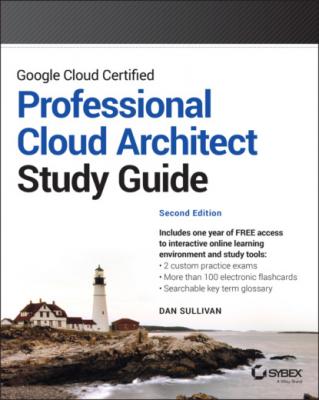Google Cloud Certified Professional Cloud Architect Study Guide. Dan Sullivan
Чтение книги онлайн.
Читать онлайн книгу Google Cloud Certified Professional Cloud Architect Study Guide - Dan Sullivan страница 16

Durability
Observability
Availability is a measure of the time that services are functioning correctly and accessible to users. Availability requirements are typically stated in terms of percent of time a service should be up and running, such as 99.99 percent. Fully supported Google Cloud services have SLAs for availability so that you can use them to help guide your architectural decisions. Note, alpha and beta products typically do not have SLAs.
Reliability is a closely related concept to availability. Reliability is a measure of the probability that a service will continue to function under some load for a period of time. The level of reliability that a service can achieve is highly dependent on the availability of infrastructure upon which it depends.
Scalability is the ability of a service to adapt its infrastructure to the load on the system. When load decreases, some resources may be shut down. When load increases, resources can be added. Autoscalers and managed instance groups are often used to ensure scalability when using Compute Engine. One of the advantages of services like Cloud Storage and App Engine is that scalability is managed by GCP, which reduces the operational overhead on DevOps teams.
Durability is used to measure the likelihood that a stored object will be retrievable in the future. Cloud Storage has 99.999999999 percent (eleven 9s) durability guarantees, which means it is extremely unlikely that you will lose an object stored in Cloud Storage. Because of the math, as the number of objects increases, the likelihood that one of them is lost will increase.
Observability is the ability to determine the internal state of a system by examining outputs of the system. Metrics and logs improve observability by providing information about the state of a system over time.
The Google Cloud Professional Cloud Architect exam tests your ability to understand both business requirements and technical requirements, which is reasonable since those skills are required to function as a cloud architect. Security is another common type of nonfunctional requirement, but that domain is large enough and complex enough to call for an entire chapter. See Chapter 7, “Designing for Security and Legal Compliance.”
Exam Case Studies
The Google Cloud Professional Cloud Architect certification exam uses case studies as the basis for some questions on the exam. Become familiar with the case studies before the exam to save time while taking the test.
Each case study includes a company overview, solution concept, description of existing technical environment, business requirements, and an executive statement. As you read each case study, be sure that you understand the driving business considerations and the solution concept. These provide constraints on the possible solutions.
When existing infrastructure is described, think of what GCP services could be used as a replacement if needed. For example, Cloud SQL can be used to replace an on-premises MySQL server, Cloud Dataproc can replace self-managed Spark and Hadoop clusters, and Cloud Pub/Sub can be used instead of RabbitMQ.
Read for the technical implications of the business statements—they may not be stated explicitly. Business statements may imply additional requirements that the architect needs to identify without being explicitly told of a requirement.
Also, think ahead. What might be needed a year or two from now? If a business is using batch uploads to ingest data now, what would change if they started to stream data to GCP-based services? Can you accommodate batch processing now and readily adapt to stream processing in the future? Two obvious options are Cloud Dataflow and Cloud Dataproc.
Cloud Dataproc is a managed Spark and Hadoop service that is well suited for batch processing. Spark has support for stream processing, and if you are migrating a Spark-based batch processing system, then using Cloud Dataproc may be the fastest way to support stream processing.
Cloud Dataflow supports both batch and stream processing by implementing an Apache Beam runner, which is an open source model for implementing data workflows. Cloud Dataflow has several key features that facilitate building data pipelines, such as supporting commonly used languages like Python, Java, and SQL; providing native support for exactly one processing and event time; and implementing periodic checkpoints.
Choosing between the two will depend on details such as how the current batch processing is implemented and other implementation requirements, but typically for new development, Cloud Dataflow is the preferred option.
The case studies are available online here:
EHR Healthcare services.google.com/fh/files/blogs/master_case_study_ehr_healthcare.pdf
Helicopter Racing League services.google.com/fh/files/blogs/master_case_study_helicopter_racing_league.pdf
Mountkirk Games services.google.com/fh/files/blogs/master_case_study_mountkirk_games.pdf
TerramEarth services.google.com/fh/files/blogs/master_case_study_terramearth.pdf
The case studies are summarized in the following sections.
EHR Healthcare
In the EHR Healthcare cases study, you will have to assess the needs of an electronic health records software company. The company has customers in multiple countries, and the business is growing. The company wants to scale to meet the needs of new business, provide for disaster recovery, and adapt agile software practices, such as frequent deployments.
Business and Technical Considerations
EHR Healthcare uses multiple colocation facilities, and the lease on one of those facilities is expiring soon.
Customers use applications that are containerized and running in Kubernetes. Both relational and NoSQL databases are in use. Users are managed with Microsoft Active Directory. Open source tools are used for monitoring, and although there are alerts in place, email notifications about alerts are often ignored.
Business requirements include onboarding new clients as soon as possible, maintaining a minimum of 99.9 percent availability for applications used by customers, improving observability into system performance, ensuring compliance with relevant regulations, and reducing administration costs.
Technical requirements include maintaining legacy interfaces, standardizing on how to manage containerized applications, providing for high-performance networking between on-premises systems and GCP, providing consistent logging, provisioning and scaling new environments, creating interfaces for ingesting data from new clients, and reducing latency in customer applications.
The company has experienced outages and struggles to manage multiple environments.
Architecture Considerations